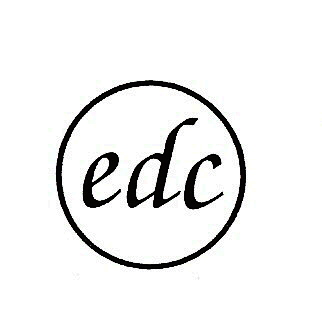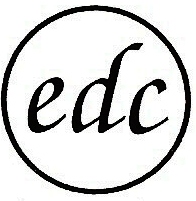Edgar David Coolidge, 1881-1967
By Dr. Christopher S. Wenckus
Edgar David Coolidge was born July 15, 1881 on a farm in Galesburg, Illinois. He attended Knox College in Galesburg from 1901-03. From Galesburg he matriculated to the Chicago College of Dental Surgery where he received his DDS in 1906. He remained there as an instructor in Operative Dentistry and Techniques until 1913. From 1913-23 he was Professor and head of Materia Medica and Therapeutics at University of Illinois, College of Dentistry. Dr. Coolidge returned to his alma mater (which became Loyola University College of Dentistry in 1923) as Professor of Therapeutics, Preventive Dentistry and Oral Hygiene in 1927 and served in this position until 1948. Dr. Coolidge had a private general dental practice (limited mostly to periodontics and endodontics) in the Marshall Field Annex Building (25 East Washington) in Chicago until he moved his practice to the Carlson Building in Evanston, Illinois in 1951 and retired from practice in 1958.
Dr. Coolidge was a student most of his life. In 1925, he received a Bachelor of Science Degree (Lewis Institute), which was followed by a Master of Science degree from Northwestern University in 1930. During this period of his life he researched to quell the controversy about the pulpless tooth and pioneered in placing endodontic practice on a sound and rational foundation.
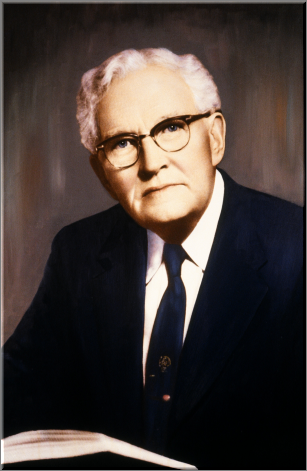
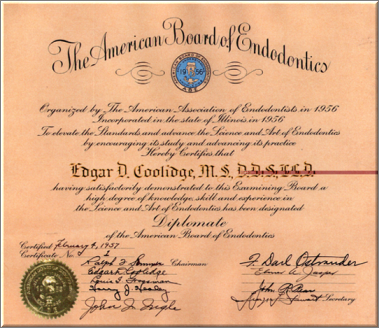
First Diplomate Certificate by the American Board of Endodontics. Note that Dr. Coolidge himself signed the 1957 certificate.
In 1948, upon his retirement as Professor Emeritus from Loyola University, Dr. Coolidge was awarded the honorary degree of L.L.D. (an honorary doctor of law degree). This was followed by an honorary Doctor of Science degree in 1959, also from Loyola. Most biographical material on Coolidge mentions that he stayed on at Loyola after retirement to do research and some teaching, but there is no indication of how long he continued his research and teaching.
Dr. Coolidge was active not only in endodontics, but left his mark on periodontics as well. He authored more than 75 articles on endodontics and periodontics. He also authored three text books; “Clinical Pathology and Treatment of Pulp and Periodontal Tissue” (2nd edition in 1946); “Endodontia” (1950); “Periodontia” (1951).
This gifted man was a recipient of many awards: in 1947 the Callahan Memorial Award from the Ohio Dental Association; in 1958 Interprofessional Council Award; in 1960 the Knox College Achievement Award and the William John Gies Award from the American College of Dentists; in 1961 the Tufts University Berkshire Award for leadership in periodontology.
Dr. Coolidge was President of the Chicago Dental Society, 1922; Illinois State Dental Society, 1923; Odontographic Society of Chicago, 1941; Fellow and President of the American Academy of Periodontology, 1947. He was a member of the Institute of Medicine of Chicago; Federation Dentaire Internationale; American Academy of Pathology; American Association for the Advancement of Science; Dental Forum of Milwaukee; American Academy of the History of Dentistry; International Dental Congress, Paris 1931; International Dental congress, Vienna, 1936; Chicago Historical Society; Evanston Historical Society; Art Institute of Chicago; Xi Psi Fraternity of which he was President in 1922.
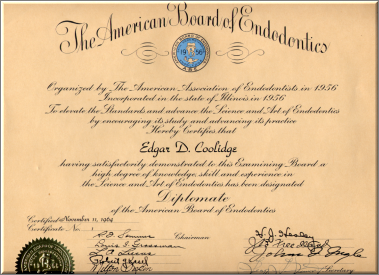
1964 re-issued Diplomate Certificate.
Dr. Coolidge was one of the initiators in organizing the American Association of Endodontists. In the AAE he served on the Advisory Committee and on the first Constitution and By-laws Committee. Dr. Coolidge was a Charter Member of the American Association of Endodontists as well as an honorary president of the Association. On February 4, 1957 he received the first Diplomate Certificate by the American Board of Endodontics, on which he was one of the nine signatories. When the AAE was finally recognized as a dental specialty in 1963, the American Board of Endodontics re-issued their first certificates in 1964 and once again, Dr. Coolidge was assigned certificate #1.
In 1946, Dr. Coolidge encouraged the members of the AAE that “the members of our association must inform themselves more and more about the nature of the tissues that we are called upon to treat. We must understand what provision nature has made to protect itself and to repair its injuries. We must take up the task of assisting nature by removal of obstacles that hinder or prevent her own mechanism of healing.” In perhaps Coolidge’s last scholarly paper (2), he admonished the profession to keep challenging our concepts. He noted that great progress has been made, but there are still many doors to open, much like what we face today. Dr. Louis I. Grossman summed up the man thus; “Dr. Coolidge will always be remembered not only as a dentist, teacher lecturer, author and researcher but also as a father figure and as a friend. One can only speak of him with words of endearment.” (3)
He was an honorary member of the Edgar D. Coolidge Endodontic Study Club.
Edgar David Coolidge passed away on August 12, 1967 at the age of 86.
